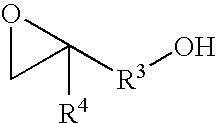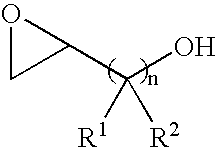Catalyst for producing both end-hydroxyl group-terminated diols, process for producing the catalyst, process for producing the diols by using the catalyst, and both end-hydroxyl group-terminated diols obtained by the process
a technology of end-hydroxyl groupterminated diols and catalysts, which is applied in the field of catalysts for producing both end-hydroxyl groupterminated diols, can solve the problems of difficult to remove carbonyl compounds by a general purification method, unreacted 3-hpa is liable to remain in the resultant 1,3-propanediol product, and odor or coloring of 3-propanediol, etc., to achieve efficien
- Summary
- Abstract
- Description
- Claims
- Application Information
AI Technical Summary
Benefits of technology
Problems solved by technology
Method used
Image
Examples
example 1
[0175] 2.0 g of sponge-Ni catalyst (trade name: R-200, mfd. by Nikko Rika K.K.) wetted with water was transferred to an autoclave made of stainless steel (mfd. by Taiatsu Glass K.K.) equipped with a stirrer and having an internal volume of 120 ml, then 20 ml of methanol was added to the catalyst and thoroughly mixed under shaking. Thereafter, the resultant supernatant was removed from the autoclave by decantation. This operation was further repeated twice, and then the same operation was conducted three times except for using 20 ml of dioxane in place of methanol to effect the solvent replacement. The resultant supernatant which had finally been obtained was removed from the catalyst by decantation, and thereafter, 30 g of dioxane and 5.00 g of glycidol were added thereto.
[0176] The reactor (vessel) was tightly closed and an operation of pressurizing the inside of the autoclave to 1.0 MPa (gauge pressure) with nitrogen and then depressurizing the inside of the autoclave to 0.0 MPa (...
example 2
[0179] 2.0 g of sponge-Ni catalyst (trade name: R-200, mfd. by Nikko Rika K.K.) wetted with water was transferred to an autoclave made of stainless steel (Mfd. by Taiatsu Glass K.K.) equipped with a stirrer and having an internal volume of 120 ml, then 20 ml of ethanol was added to the catalyst and thoroughly mixed under shaking. Thereafter, the resultant supernatant was removed from the autoclave by decantation. This operation was further repeated twice, and then the same operation was conducted three times except for using 20 ml of cyclohexane in place of ethanol to effect the solvent replacement. The resultant supernatant which had finally been obtained was removed from the catalyst by decantation, and thereafter, 30 g of cyclohexane and 5.00 g of glycidol were added thereto.
[0180] The reactor was tightly closed, and then the contents (atmosphere) of the autoclave were replaced with nitrogen, and further with hydrogen sequentially in the same manner as in Example 1, and a hydroge...
example 3
[0183] 2.0 g of sponge-Ni catalyst (trade name: R-200, mfd. by Nikko Rika K.K.) wetted with water was transferred to an autoclave made of stainless steel (mfd. by Taiatsu Glass K.K.) equipped with a stirrer and having an internal volume of 120 ml, then 20 ml of ethanol was added to the catalyst and thoroughly mixed under shaking. Thereafter, the resultant supernatant was removed from the autoclave by decantation. This operation was further repeated twice, and then the same operation was conducted three times except for using 20 ml of 1,2-dimethoxyethane in place of ethanol to effect the solvent replacement. The resultant supernatant which had finally been obtained was removed from the catalyst by decantation, and thereafter, 30 g of 1,2-dimethoxyethane and 5.00 g of glycidol were added thereto.
[0184] The reactor was tightly closed, and then the contents (atmosphere) of the autoclave were replaced with nitrogen, and further with hydrogen sequentially in the same manner as in Example ...
PUM
| Property | Measurement | Unit |
|---|---|---|
| particle size | aaaaa | aaaaa |
| particle size | aaaaa | aaaaa |
| particle size | aaaaa | aaaaa |
Abstract
Description
Claims
Application Information
 Login to view more
Login to view more - R&D Engineer
- R&D Manager
- IP Professional
- Industry Leading Data Capabilities
- Powerful AI technology
- Patent DNA Extraction
Browse by: Latest US Patents, China's latest patents, Technical Efficacy Thesaurus, Application Domain, Technology Topic.
© 2024 PatSnap. All rights reserved.Legal|Privacy policy|Modern Slavery Act Transparency Statement|Sitemap



